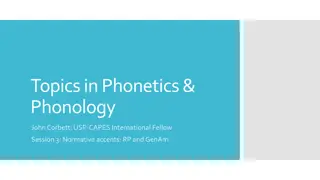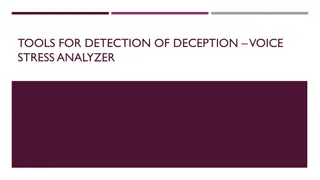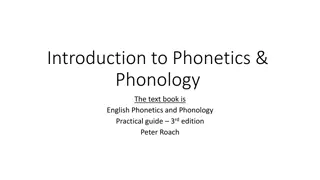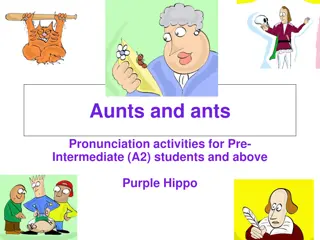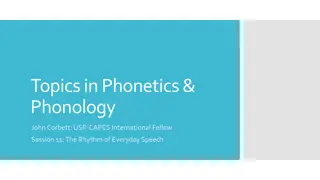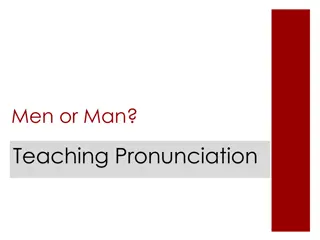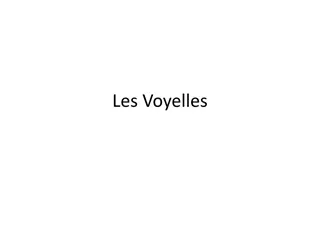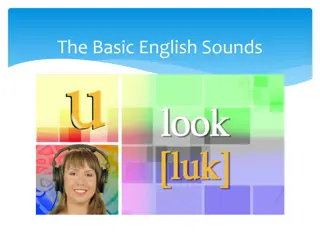Understanding Stress in English Pronunciation
Stress in English pronunciation refers to the emphasis placed on specific syllables within words. This helps distinguish degrees of emphasis or contrast in syllables, aiding in clear communication and word recognition. Learning about stress patterns is crucial for effective English communication. The nature of stress involves certain syllables being emphasized based on the structure of words. Through practice and understanding stress placement, one can enhance their pronunciation skills significantly.
Download Presentation

Please find below an Image/Link to download the presentation.
The content on the website is provided AS IS for your information and personal use only. It may not be sold, licensed, or shared on other websites without obtaining consent from the author. Download presentation by click this link. If you encounter any issues during the download, it is possible that the publisher has removed the file from their server.
E N D
Presentation Transcript
1 Stress in Simple Words Chapter -10- Subject Lecturer: Alaa NawzadAwla Assistant Lecturer M.A holder Course s name: Phonics 3rdWeek of October
Contents: 2 1. What is Stress? How can we Define it? 2. Why studying Stress? 3. What is the Nature of Stress? 4. What is Prominence in English Syllables? 5. What Makes a Syllable Prominent? 6. What are the Levels of Stress? How many Levels of Stress in English? 7. Placement of Stress within a Word? How to Place a Stress in a Simple Word? 8. Placement of Stress in Two-Syllable Words 9. Placement of Stress in Three-Syllable Words
3 What is Stress? How Can we Define it in Phonology?
4 What is Stress? The word Stress basically means putting emphasis on something, or focus attention on and draw attention to. It is usually equated with an undifferentiated notions of emphasis , strength , intensity and prominence. In English, we do not say each syllable with the same force or the same degree of loudness and strength. In one word, we accentuate one syllable. We say one syllable very loudly (big, strong, important) and all the syllables with very less force or quietly. This variety of degree is noticeable to a listener. Phonetically, stress refers to a degree of force with which a syllable is uttered or it is a degree of prominence a syllable has. From the viewpoint of phonology, the main function of stress is to provide a means of distinguishing degrees of emphasis or contrast in syllables of words in a sentence. Stress is an important feature of English pronunciation and to become a powerful communicator of English, one needs proficiency while using different stress patterns in his communication. Listeners use it to recognize the words you say. To speak clear English that people understand easily, you need to use good word stress.
Lets practise! 5 Lets take three words: 1. Photograph / f t gra:f/ (v.) - (n.) 2. Photographer /f t gr f / (n.) 3. Photographic /f t gr fIk/ (adj.) Do they sound the same when spoken? No, because we accentuate (stress) one syllable in each word. And it is not always the same syllable since the shape of the each word is different. Each part of speech has its own pattern of stress.
9 The Nature of Stress The nature of stress is simple, practically everyone would agree that the first syllable of words like father , open , camera is stressed, and that the middle syllable of words like potato , apartment , relation is stressed, and the final syllable of words like about , receive , perhaps is stressed. In order to understand the nature and characteristics of a stressed syllable, we have to take into our consideration two aspects: 1. What a speaker does in producing stressed syllables? 2. What characteristics of sound make a syllable seem to a listener to be stressed? To understand the nature of syllables, we have to focus of production and perception then. These two notions are closely related, but are not identical. The production of stress is generally believed to depend on the speaker using more muscular energy than is used for unstressed syllables. According to experimental studies, that when we produce stressed syllables, the muscles that we use to expel air from the lungs are often more active, producing higher subglottal pressure.
It seems probable that similar things happen with muscles in other parts of our vocal apparatus. 10 Regarding the perception view, it is clear that many different sound characteristics are important in making a syllable recognizably stressed. All those vowel sounds that make stressed syllables have one characteristic in common, and that is prominence. Stressed syllables are stressed because they are more prominent than unstressed syllables. Most audible and hearable A syllables is prominent because of four factors: 1. Stressed syllables are louder than unstressed syllables. (Loudness) 2. The length of the syllables; if one syllable is longer than the others, there is quite a strong tendency to hear it as stressed. (Length) 3. Every voiced syllable is said on pitch. The pitch of the syllable; pitch in speech is related to the frequency of vibration of the vocal cords and the musical notion of low and high pitched notes. (Pitch) 4. A syllable will tend to be more prominent if it contains a vowel that is different in quality from neighbouring vowels. (Quality) These four factors work together in combination, although syllables may sometimes be made prominent by means of only one or two of them.
11 What are the Levels of Stress? Or levels of Syllables? Up to this point we have talked about stress as though there were a simple distinction between stressed and unstressed syllables with no other intermediate levels between these stressed and unstressed levels. There are basically four levels of stress: primary, secondary, tertiary and unstressed stress levels. Primary stress: is the first and strongest type of level that results from the pitch movement or tone when the prominence occurs. The syllable with the Primary Stress is the loudest and longest syllable in a word. It has a very noticeable change in pitch on the vowel. It is a strong emphasis a speaker puts on the most important syllable in a word. For example, the second syllable in the word around / r a nd/ has a primary stress. In one-syllable words, that one syllable gets the primary stress. Examples: blue = /blu:/=/BLUUU/ ten = / en/ =/TEHN/ The only exceptions to this rule are a handful of function words like the which are usually unstressed or reduced.
12 Secondary Stress: is the stress that comes second after the primary stress; this type of stress is weaker than the primary stress but stronger than the unstressed syllables. These are the syllables that are stressed, but not as much the primary stress, so they are loud and long with a change in pitch, but not as loud or as long as the syllables that get the primary stress. The change in pitch on the vowel is not quite as noticeable. For example, in the word photographic / f t gr fIk/, the first syllable has the secondary stress. Example: disappear / dIs pI / = /DIH-suh PEEER/ (syllable with secondary stress is underlined) Unstressed level: is the third type of stress which is the weakest; it is regarded as being the absence of any recognizable amount of prominence. These are the syllables that have no stress at all so we rush through them and shorten them so much that the vowel in the syllable is almost completely gone. The change in pitch on the vowel is barely noticeable, but it is there. For example, the first syllable of the word attend has the unstressed level / tend/. Example: prepare = /prI p3:/ = /pruh-PAIR/ (unstressed syllable is underlined)
13 It is worth noting that unstressed syllables containing / , I, i, u/ or syllabic consonants, will sound less prominent than those unstressed syllables containing some other vowels. For example, the first syllable of poetic /p eI tIk/ is more prominent than the first syllable of pathetic /p et Ik/ . The first syllable of the word poetic makes a different level of syllable for unstressed syllables because the degree of its prominence is quite high in comparison with the syllables whose peaks are made with one of the weak syllable vowel sounds. There is also a tertiary level of stress in some polysyllabic words. In the word indivisibility / In.dI. vIz. . bIl. t.i/ for example, there are four different stress levels. The syllable /bIl/ is the strongest, carrying the primary stress. The initial syllable /In/ has a secondary stress, while the third syllable /vIz/ has a level of stress (tertiary) which is weaker than those two but stronger than the second, fourth, sixth and seventh syllables (which are all unstressed).
14 Tertiary level of stress is in between strong and weak syllables in a word. Primary Stress Secondary stress Weaker Tertiary Stress Stronger any Weak syllables The important part of all of this is... It s the contrast between all these different levels of loudness, duration, and pitch that creates the rhythm of English.
15 Placement of Stress within Words English is not one of those languages where word stress can be decided simply in relation to the syllables of the word. - French (where the last syllable is stressed) - Polish (where the syllable before the last is stressed) - Czech (where the first syllable is stressed) English word stress is not an optional extra topic like some of other languages that you can add to the English language. It is part of language. English speakers use word stress to communicate rapidly and accurately, even in difficult conditions. If, for example, you do not hear a word clearly, you can still understand the word because of the position of the stress.
18 English word stress is so difficult to predict that it is best to treat stress placement as a property of the individual word, to be learned when the word itself is learned. When English speakers come across an unfamiliar word, they can pronounce it with the correct stress; in principle, it should be possible to discover what it is that the English speaker knows and to write it in the form of rules. In order to decide on stress placement, it is necessary to make use of some or all of the following information (these four points can decide on the stress pattern): 1. Putting stress pattern changes according to the form of the word (whether the word is simple, complex, or compound) 2. What the grammatical category of the word is (noun, verb, adjective, ..etc.) 3. How many syllables the word has. 4. What the phonological structure of those syllables is. Single-syllables words present no problems: if they are pronounced in isolation, they are said with primary stress. One word, one stress; one word cannot have two stresses. So if you hear two stresses, you have heard tow words.
19 The 4th point affects all the other three points. It is said that the structure of strong syllables is as the following: 1. Either a syllable peak is a long vowel or diphthong, with or without a following consonant (coda). For example, in words like die , heart , see , air ..etc. 2. Or a syllable peak is a short vowel followed by at least one consonant. For example, in words like bat , much , pull ..etc. The important point to remember is that, although we do find unstressed strong syllables as in the last syllable of the word dialect / daI lekt/, only strong syllables are stressed. Weak syllables are always unstressed.
20 Two-Syllable words In the case of simple two syllable words, either the first or the second syllable will be stressed; we can never have the both syllables stressed at the same time. If the grammatical category of the word is verb, then the general tendency saying hat the stressed syllable will be closer to the end of a word. Examples: Include /In klu:d/ Become /bI k m/ Allow / la / Believe /bI li:v/ Suggest /s d est/ Provide /pr vaId/ The general tendency for nouns is that the stressed syllable will be closer to the beginning of a word. Examples: Window / wInd / Candy / k ndi/ Blackbird / bl kb3:d/ Birthday / b3: deI/ Popcorn / p pk :n/ Bathtub / ba: t b/
21 With verbs, if the final syllable has one of the weak vowel sound peaks, then the first syllable is stressed: Examples: Enter / ent / Open / p n/ Envy / envi/ Equal / i:kw l/ With verbs, a final syllable is always unstressed if the peak contains / / sound. Examples: Follow / f l / Borrow / b r / With verbs, if the final syllable is strong, then that syllable is stressed even if the first syllable is strong too. Examples: Rotate /r teIt/ Maintain /meIn teIn/
22 With nouns, if the first syllable has one of the weak vowel sound peaks, then the last syllable is stressed. Examples: Divan /dI v n/ Balloon /b lu:n/ Design /dI zaIn/ With two syllable simple adjectives, we have got the same rules as we have for verbs: Examples: Lovely / l vli/ Alive / laIv/ Hallow / h l / Divine /dI vaIn/ Even / i:v n/ There are exceptions with the two adjective words honest / nest/, and perfect / p3:fIkt/; both of which end with strong syllables, but are stressed on the first syllables. Some other two syllable words such as adverbs seem to behave like verbs and adjectives. To sum up, verbs, adjectives, and adverbs have the same stress pattern rules.
23 Three-syllable Words With simple verbs of three syllables words if the final syllable is strong, then it will receive the primary stress. Examples: Entertain / ent teIn/ Resurrect / rez rekt/ Understand / nd st nd/ Represent / reprI zent/ Recommend / rek mend/ Interrupt / Int r pt/ If the last syllable is weak, then it will be unstressed, and stress will be placed on the preceding syllable if that syllable is strong. Examples: Encounter / I ka nt / Determiner / dI t3:mIn/ Remember / rI memb / If both the third and second syllables are weak, then the stress falls on the initial syllable. Examples: Parody / p r di/ Monitor / m nIt / Recognize / rek gnaIz/ Generate / d en reIt/ Implement / Im plIm nt/
24 Nouns with three syllables require a slightly different rule. The general tendency is for stress to fall on the first syllable unless it is weak. Examples: Quantity / kw nt ti/ Emperor / em p r / Custody / k st di/ Enmity / enm ti/ However, in words with a weak first syllable the stress comes on the next syllable (middle syllable). Examples: Mimosa / mI m z / Disaster / dI za:st / Potato /p teI t / Synopsis /sI n psIs/ When a three-syllable noun has a strong final syllable, that syllable will not usually receive the main stress; the stress will mostly be on the first syllable. Examples: Intellect / Int lekt/ Marigold / m rI g ld/ Alkali / lk laI/ Stalactite / st l k taIt/ Adjectives with three-syllables seem to have the same stress pattern rules as nouns with three syllables. Anthropoid / n r p Id/ Insolent / Ins l nt/ Opportune / p tju:n/ Derelict / der lIkt/
Exercise! 26 Transcribe the following words then place the primary stress over the correct syllable. Arrive Export Protect Language Photographer Conduct Injurious Clamber Captain Honest Photography Correct Festoon Career Placement Produce Maintain Detest Paper Determine Entertain Exist Bellow Event Entertain Protest Separate (v.) Menace Jonquil Intellect Reflexive Examiner Disconnect Injury Movement Opportune Quantity Enter Connection Perfect
27 k ju i end




